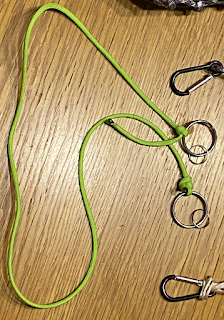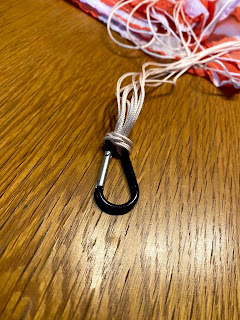After a fair amount of experimentation, I am very pleased to have successfully figured out how to deliver a beer via drone.
And I am even more pleased to share this breakthrough with the aviation world. I Googled this problem hard. Lots of people provided terrific insight into individual parts of this problem, but no one, as far as I can tell, put all the pieces together. (You're welcome. Nobel prize nomination instructions are found here.)
This project was launched during the 2020 coronavirus pandemic, but future generations should not assume that the aims of this project were any more important during the era of social distancing. They were not. It was a pure "waste of time"/"holy quest." Even in pandemic times, you could just leave a beer on your friend's porch if you wanted your friend to have a beer.
I am realizing as I write this that I have included a lot of links to Amazon products. I don't do any sort of affiliate program; I just literally bought most of this stuff from Amazon. Also, I probably could have cut this into a YouTube video, but it's easier for readers to absorb the details in text form, and I don't have a YouTube channel I'm pushing.
Please also note well that there are also likely federal laws that prescribe what you can drop with a drone, as well as state liquor laws that would prohibit dropping a beer to a minor. It is your responsibility to find out what these are and act accordingly.
EQUIPMENT USED
| Drone: A DJI Mavic Air 2. The Mavic Air 2, which weighs only 570 grams, can lift a surprising amount; one test showed it can lift another 830 grams, for "a whopping power index of 1.43," as calculated by DroneDJ.com. |  |
Air Dropper: A remarkably cheap air dropper ordered from AliExpress.com. Delivery was posted as being around 2 months, but I received it in 24 days for a total of $25.20, including shipping. It basically works by watching the auxiliary light on the drone, and pulling back a pin (thus releasing the payload) when that light turns on. It works (see my short review). Other, presumably much better, droppers can cost around $160. I'm sure they're great, but I'm super-happy with this one. |  |
Parachute: A very nice Apogee 36" ripstop nylon chute, ordered from Amazon. ($17.80 + $9.20 shipping – not sure why such a light item cost nine bucks to ship...) Some parachutes have some way to attach something to the top of them, which might have made dragging it into the air easier. This one does not. |  |
Beer: 12 oz. can of Budweiser. Beer bottles weigh too much, 556 grams vs. 368g for the can. (Bud Lite would weigh even less, obviously.) |  |
Beer sling: Homemade from paracord (instructions here). |  |
Other materials: Thick split rings, $6.91 for 10 from Amazon, to connect parachute to payload. Lesser split rings failed to handle the force of the parachute snapping open, as we shall see. Lesser split rings I scavenged from key tags I had around the house, which were good for other uses. Standard paracord I already had. Cheap carabiners I had around the house. For the stresses that can be generated by the size payload a Mavic Air 2 can lift, these seem to hold up just fine. None have shown any deformation in the tests I've run. |  |
WEIGHTS AND MEASURES
| What's strapped to the drone | |
| Air Dropper (without legs) | 53g |
| Connecting cord (with 2 strong, 2 lesser split rings) | 17g |
| Parachute with cheap carabiner | 43g |
| Paracord can holder with cheap carabiner | 48g |
| All equipment: | 165g |
Payload: Can of Budweiser | 368g |
Total lifted load: | 533g |
| Mavic Air 2's total tested lifting capacity (though it cannot really navigate with this much aboard) | 830g |
Some individual components | |
| Strong split rings (apiece) | 6g |
| Cheap carabiners (apiece) | 4g |
| Legs for the Air Dropper | 18g |
Two things I didn't lift | |
| Bottle of beer (Heineken) | 556g |
| Life jacket (standard Stearns) | 460g |
But it turns out that a standard Stearns life jacket weighs about halfway between a beer can (which works) and a beer bottle (which doesn't). So it might not be nearly as ridiculous as I thought.
Plus, you would drop the life jacket directly, with no parachute or holder. The rescue drone would likely just be carrying the Air Dropper (53g) + the connecting cord (17g) + the life jacket (460g), for a total of 530g, a hair less than the beer can, sling, and parachute (533g). Wind resistance could be an issue, though.
Clearly, more testing is needed. It is apparent even now, though, that you must choose to save someone by dropping either a beer or a life jacket to them, but not both. Choose wisely.
TRIAL AND ERROR: ERROR SECTION
Here are the things that do not work, at least with a drone of the Mavic Air 2's lifting capability:
1. Bottles of beer: I first tried deploying bottles of beer, because bottles seemed classier. The Mavic Air 2 struggled mightily to lift the bottle, and was able to do it, but just barely. It could sometimes climb to an altitude but be unable to maintain it. This just wasn't going to work.
Also, I first tried this rubber sling, which is built to hang a water bottle on your waist:

I did get the bottle and the rubber sling up to a good height, and it dropped magnificently from the air dropper. The parachute deployed flawlessly. But, perhaps immensely predictably, when the cords all snapped taut upon the parachute's opening, the bottle slipped right out of its rubber holder and plunged to the grass below.
Remarkably, the bottle survived the fall unbroken and unopened, but the incident convinced me that cans are the way to go. As mentioned above, a beer can weighs 368 grams vs. 556 grams for the bottle, a significant savings.
2. Thin rings bearing weight: After switching to cans, I did tests with cans of seltzer water we had around (less mess in case of disaster), and connected parachute to cargo with split rings found on cheap key tags we had around:
The first drop worked beautifully. But I failed to check my equipment on the repeat drop, though, and the can plunged to the ground and destroyed itself. (This was the only payload loss of the project: No beers were harmed.)
The rings had clearly bent a bit on the first drop and that middle one there failed altogether on the second drop:

These rings ended up working nicely for another use (clipping the whole package to the air dropper itself), but were not able to hold up to the force of the parachute snapping open and decelerating the payload. I bought heavier rings ($6.91 for 10 from Amazon), and they work nicely:

3. Going too high. At 120 feet, even with hardly any wind, the parachute drifted off into a tree:
I was able to rescue it by tying a gravity hook that doubles as a grappling hook ($33.99 at a Amazon for two of 'em) to the drone and fishing the chute out of the tree:

This is exactly the kind of task I bought the grappling hook for, and if you wonder whether it makes its user feel like Batman, yes, it does.
TRIAL AND ERROR: SUCCESS SECTION
So, here's what did work for me. (If someone wants to write to me and tell me how people who actually know what they're doing build a payload-parachute package, I'm all ears.)
Fold the parachute up nicely:
(I learned this from this YouTube video, where they actually did a much more careful job. Feel free to fold your parachute more carefully than I did.)
2. CONNECTING CORD: This has the strong rings tied to the ends, and the small rings attached to them. Parachute and payload get attached to the strong rings on either end, and the small rings attach to the air dropper. This holds the whole package in place nicely, and allows the weight of the payload to pull the parachute open. |  |
3. PAYLOAD CONTAINER: This doesn't look very impressive: |  |
But check it out when it has a beer can in it!: |  |
This sling is very sturdy. (Again, instructions here.) A metal ring at the bottom has been wrapped by many loops of paracord, which makes sure the can does not slip out, even under force: |  |
| Wrapping the parachute: After you connect all three pieces, the trick is to hold the parachute and wrap the connecting cord tightly around the parachute, then gather the two small rings together: This holds everything together as the payload is lifted. When both small rings are released when the payload is dropped, the weight of the payload immediately begins to spin the cord off the chute, pull the parachute lines out of the parachute, and pops the parachute open. |  |
Launching the drone: Keep the payload away from the propellers. It works to tuck the chute under the drone, or right next to the gimbal. If you tip it back too far, though, the rear props might hit the ground when they spin up. The air dropper came with leg extenders, which I was too lazy to put on, but which would probably have made a launch a little easier. A hand launch would also work well for this. (Landing is easier, as the parachute should no longer be attached.) |  |






Nice!
ReplyDelete